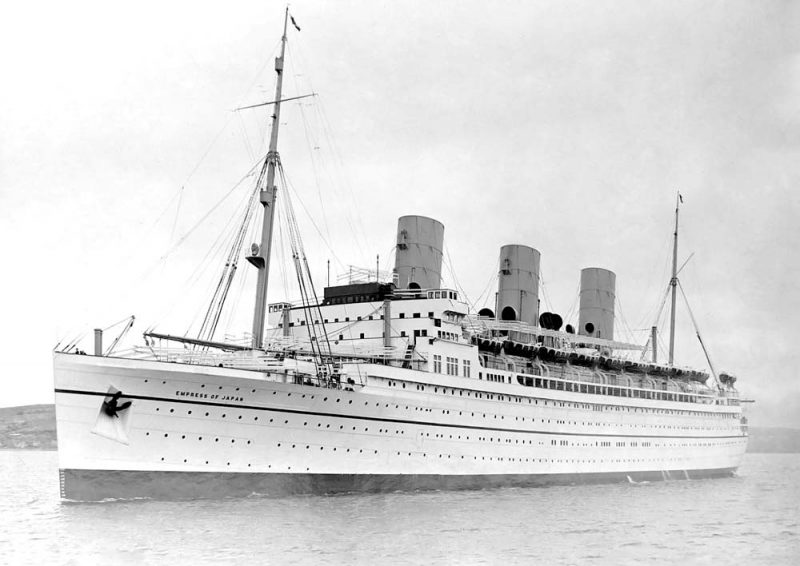![]()
 This famous liner was the fastest passenger ship on the Pacific when completed in 1930, known as the ‘Queen of the Pacific’, and she was particularly noted for her stunning First Class Art Deco public room interiors. She was the second of the name in the Canadian Pacific Steamships (CPS) fleet, the first Empress of Japan having been completed in 1891 as a member of the first trio of liners for the Canadian Pacific Railway (CPR) ten year Transpacific Mail Contract. The first Empress of Japan served as an Armed Merchant Cruiser (AMC) in the Pacific during the Great War in 1914/15 and recaptured a British collier that had been taken by the German light cruiser Emden. She was laid up in the second half of 1922 at Vancouver and despite being sold twice abortively, she remained at anchor at Vancouver until she was demolished at Burrard Inlet at North Vancouver in the Spring of 1926, her bell now hangs in the Merchants Exchange Building at Vancouver with her figure head in Stanley Park in Vancouver.
This famous liner was the fastest passenger ship on the Pacific when completed in 1930, known as the ‘Queen of the Pacific’, and she was particularly noted for her stunning First Class Art Deco public room interiors. She was the second of the name in the Canadian Pacific Steamships (CPS) fleet, the first Empress of Japan having been completed in 1891 as a member of the first trio of liners for the Canadian Pacific Railway (CPR) ten year Transpacific Mail Contract. The first Empress of Japan served as an Armed Merchant Cruiser (AMC) in the Pacific during the Great War in 1914/15 and recaptured a British collier that had been taken by the German light cruiser Emden. She was laid up in the second half of 1922 at Vancouver and despite being sold twice abortively, she remained at anchor at Vancouver until she was demolished at Burrard Inlet at North Vancouver in the Spring of 1926, her bell now hangs in the Merchants Exchange Building at Vancouver with her figure head in Stanley Park in Vancouver.
Empress Of Japan (2)
She was launched at the Govan yard of Fairfield Shipbuilding and Engineering Co. Ltd. on 17th December 1929, and her three great funnels, the third was a dummy, were fitted in the Spring of 1930. As completed in June 1930, she had a gross tonnage of 26,032 and accommodation for a total of 1,173 passengers, with 399 in First Class, 164 in Second Class, 100 in Third Class and 510 in Asiatic steerage, and with a crew of 579. She was given a wide open Promenade Deck for use by the First Class passengers in fair Pacific weather. She sailed from Liverpool on 14th June 1930 on her maiden voyage to Quebec and returned in triumph to Southampton to begin the long voyage eastwards to Hong Kong and Yokohama via the Suez Canal on 12th July 1930. She had a white hull and never had a peacetime black hull as did many of the CPS Transatlantic fleet, for example the ‘Duchess’ quartet. She was the fastest and finest CPS Transpacific liner when she sailed from Hong Kong on 7th August 1930 for Yokohama and Vancouver.
She had a designed overall length of 666 feet, a length between perpendiculars of 640 feet, moulded beam of 83.8 feet and a depth to Shelter Deck of 48.5 feet and to Boat Deck of 73.6 feet. Her maximum loaded draft was thirty feet, and the length of her combined fo’c’stle and Bridge Deck ‘A’ was 578 feet, and her Promenade Deck was of length 459 feet and her Boat Deck of length 348 feet. She had ten decks named in descending order as Sun Deck, Boat Deck, Promenade Deck, Bridge Deck ‘A’, Shelter Deck ‘B’, Upper Deck ‘C’, Main Deck ‘D’, Lower Deck ‘E’, Orlop Deck ‘F’, and Hold Deck ‘G’. She was given luxurious Art Deco style public rooms on Promenade Deck so that she could compete with three luxurious Japanese NYK liners already on the Pacific service as Asama Maru, Tatsuta Maru and Chichibu Maru with fast speeds of 21 knots from Sulzer diesels.
However, Empress of Japan (2) was given steam turbine machinery manufactured by her builders with six watertight boilers producing steam at 425 psi for passing to two sets of three single reduction steam turbines and giving a service speed of 22 knots from her twin propellers. She was designed by naval architects C. S. Douglas & Company of Glasgow and given a pleasing profile of three well proportioned, raked and equally spaced funnels, an elegant and imposing superstructure that rose no less than 87 feet from the waterline. She was given twenty lifeboats on Boat Deck, with two tall masts and three sets of posts for cargo handling to her 380,000 cubic feet of cargo capacity, of which 33,000 cubic feet was refrigerated and a further 59,000 cubic feet was for the carriage of silk in four special Silk Rooms. She had a cruiser stern with her hull bossed out to enclose the lines of her shafting right aft to the propellers. A streamlined rudder of the semi-balanced type was fitted to give a straight and less confused wake at her stern.
She had a dozen transverse bulkheads extending to Upper Deck ‘C’ and their distribution was such that a standard two compartment type of vessel was attained. The openings in the bulkheads necessary for working and service arrangements were fitted with watertight doors, all able to be closed simultaneously from the navigating bridge with audible signals at each door when the officer of the watch closed them. Fire resisting bulkheads were fitted above the main bulkheads at intervals in accordance with the regulations. A cellular double bottom extended over the full length of the vessel between the fore peak and the aft peak, being subdivided transversely into thirteen compartments for oil fuel and water ballast, with the fore and aft peaks also for water ballast and particularly used to effect the trim of the vessel. Large fresh water tanks were incorporated in the hull structure at the sides of the engine room and abreast the shaft tunnels.
First Class Public Rooms

The First Class Dining Room was located ‘midships on Upper Deck (‘C’ Deck) and was one of the finest dining rooms afloat, and decorated with Cipollino marble for the lucky 274 passengers seated at the mahogany tables and carver chairs. It was entered from the First Class Foyer along both sides of the centre funnel casing. There were also two small private dining rooms seating a further twenty passengers on the starboard side of the Foyer. The Foyer extended the full width of the ship and was decorated in Louis XIV style, and was ably supported by marble columns with bronze enrichments. Diners were brought to the Foyer by two passenger elevators at the forward end of the room, and they then passed through teak framed glass doors to the Dining Room. The predominant colours of the gorgeous Dining Room were grey, green and blue, relieved by gilded bronze mountings. The sidelights of this great room were screened by sliding windows and provided with carved teak shutters to give a feeling of warmth for the duration of the meal. This room was extremely elegant in appearance, with an Art Deco ceiling with circular motifs, and added Art Deco touches such as those to the circular serving areas throughout the room of tall ‘flower stem’ lights with downward drooping petal shades.

The First Class Ballroom was on the Promenade Deck as were all of the First Class public rooms with the exception of the Dining Room. All of the public rooms on Promenade Deck were fourteen feet in height, with large domes over the Lounge, Smoking Room and stairway. The lovely Ballroom was at the forward end of Promenade Deck and extended the full width of the ship with panelled walls in natural oak enriched with gilding. There were excellent sea views through tall windows forward and to port and starboard. The ship’s orchestra with piano played on a platform at the aft end of the room, which was surrounded by two standard bay trees, potted palms and flowers in pots. The electric lighting concealed in the richly decorated Art Deco style ceiling was capable of instantaneous colour changes. The large open parquetry floor was perfect for dancing the night away.
The First Class Long Gallery on the port side of Promenade Deck led directly from the Ballroom to the First Class Lounge. The First Class Main Entrance Hall was entered by stairs from the Entrance Hall below on Bridge Deck (‘A’ Deck) and was in the centre of this space, with the First Class Writing Room, Card Room and Children’s Room on the starboard side. The Long Gallery was decorated in ash and walnut picked out in gilt. There was also a Shop with attractive colonnades facing the stairway, the latter panelled in ash and walnut and flanked by massive carved balustrades. Revolving doors led to the open deck, and the passenger lifts gave ready access to decks above and below.
The First Class Writing Room and adjoining Card Room had walls panelled in the early Georgian manner, with cream effects in the Writing Room and light coral effects in the Card Room. Soft, subdued lighting reflected from ceiling coves and showed to advantage the elegant mahogany furniture and the marble fireplace.
The First Class Lounge was a stunning room lit by a large elliptical skylight giving natural light from the Boat Deck above. It was decorated in the ‘Empire’ style in pale wood with gorgeous gold and blue brocade furnishings. A semicircular stage for concerts was at one end with a fireplace and a large ormolu decorated mantle clock above at the other end of the room. The grand piano on this stage was one of four pianos on the ship, the others being in the First Class Ballroom, the musicians’ balcony in the First Class Dining Room, and in the Second Class Lounge. The parquetry floor was used for dancing in this most elegant of rooms.
The First Class Smoking Room was a full width room entered from the First Class Lounge and had an inlaid teak floor with specially selected light grained mahogany framing and studded with bronze to give a trellis effect. The outstanding feature of the room was the enormous stone fireplace and chimney piece of carved Roman stone, crowned with a cut glass overmantel, etched with oriental elephants and other animals.
The First Class Verandah Café was entered from the First Class Smoking Room, and had high windows with overhead bronze metal balustrades for plants and flowers. Dark cane chairs, furniture and richly decorated carpets and floors gave a relaxed feeling to the room. On exiting through the side doors into the outer promenading area of Promenade Deck, a walk of three hundred feet forward brought one to the First Class Ballroom.
Subscribe today to read the full article!
Simply click below to subscribe and not only read the full article instantly, but gain unparalleled access to the specialist magazine for shipping enthusiasts.






Comments
Sorry, comments are closed for this item